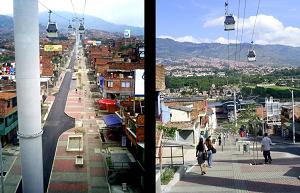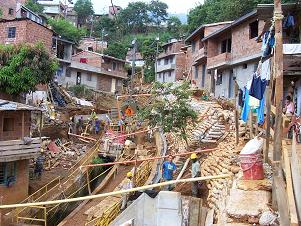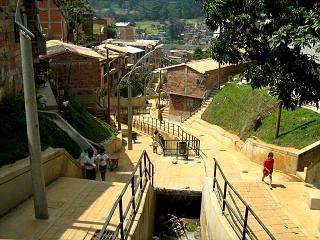Core of Capacity Development (CD): Mutual Learning and Collaboration
2011.02.24
Shifting from aid, that simply provides goods and money, to assistance, that encourages developing countries’ independence and helps improve their problem-solving abilities—. Amidst such trend in the international community, "capacity development (CD)" (see *1) has become one of the key issues in development assistance. To apply the CD concept in the field of international cooperation, JICA-RI is aiming to clarify its application possibilities and to explore aid approaches suitable for local contexts of recipient countries and regions.
No Sustainable Development Possible without CD
"Tangible factors such as funding, equipment and technology are not the only things that enable sustainable development. Intangible aspects like power of people and organizations are also crucial. With continuous CD process, developing countries stand a better chance of robust growth. CD has a potential to become a critical driving force of international cooperation," Mine Sato, research associate participating in JICA-RI's CD research project, expresses her view.
The significance of CD has been widely recognized in the international community. However, it is not yet clear as to what elements are involved in the process and how they interact with one another, as well as how donors should support the process. In fact, as it is considered difficult to apply this concept to actual ODA projects, there’s a gap between the notion and operations on the ground.
JICA-RI's research project "Revisiting the Capacity Development Approach through Comparative Case Analysis" (conducted by director Akio Hosono, research associates Shunichiro Honda, and Sato) was launched with the aim to integrate the concept of CD into development assistance operations by systematizing its process. The team examines selective good practices from JICA's past ODA projects which contributed to capacity improvement in recipient countries. One of the examples is the case study of the land readjustment and urban development project in Colombia’s second largest city Medellín. The city, notorious for its high crime rate in the past, has been transforming into a safer and peaceful city in recent years. Of the people that were actively involved in its redevelopment process, some were once trainees of a JICA's program.
Metrocable: An Innovative Urban Transportation System
On the slopes surrounding Medellín's central valley lies a large slum of 158 hectares with some 230,000 residents. From February 11 to 15, 2011, Hosono visited the neighborhood of Juan Bobo district, the pilot project site of the partial redevelopment of the mega slum, to study how it was implemented.
Hosono says, "Colombia's overall crime rate has greatly improved in the past decade. Vigorous efforts by the police authority as well as reconciliation between the government and some armed groups are identified as the key factors behind this. And in Medellín, the improvement was even greater than other major cities. Unlike others, the collaborative efforts of the city government and residents in the modest but consistent slum redevelopment are seen as the important contributor to this change."
What led to the first breakthrough of the improvement was the introduction of cable cars. With the purpose of providing a commuter service for slum residents, a cable car system called Metrocable was built on the steep hills in the city's northwestern region where the major slum is located. The resulting effect was enormous. "Cable cars for tourism are abundant all over the world, but Medellín's Metrocable is the world's first case used as a means of public transport. It is also unique that most of the beneficiaries are low-income citizens." Hosono explains.

Photo: provided by Empresa de desarrollo
Urbano - EDU (Medellin)
The cable car system connects to the city’s train system that runs through the central Medellín, which drastically reduced commuting time of the slum residents and improved their income. It also contributed to facilitating police operations and bringing peace and order. According to the local government of Medellín, its homicide rate dropped from 381 per 100,000 people in 1991 to 26 in 2007.
With the installment of the Metrocable, the city implemented land readjustment projects in slum areas such as Juan Bobo which surround the stations. Shacks were replaced with 5 to 6-story apartment buildings. Thanks to the expansion of available space, narrow pathways were widened and public facilities such as schools, libraries, and parks were built to serve the community. And banks opened a branch near the stations. The cable car system and urban redevelopment project triggered drastic changes in the living environment of the slum.
Active Role of JICA's Training Participants
The Colombian Government and agencies in charge of the development and planning of major urban areas, such as Bogotá and Medellín, have been putting efforts in redeveloping cities by providing housing for low-income households and enhancing urban transportations. Some of the officials working there are, in fact, once participants of the training course titled "Training Course for Urban Planning and Land Readjustment" at JICA Obihiro International Center (see *2). Many former participants have conducted operations such as the regional planning of Bogotá and Medellín by referring to the knowledge acquired in Japan. Their experiences in Japan have also been useful in examining how they should implement redevelopment projects in impoverished communities.
By directly talking with local community leaders of the Juan Bobo district of Medellín as well as officials from Medellín's Urban Development Enterprise (EDU), which mediated between the local government and residents, Hosono identified three distinctive features of this project: 1) The fostering of an understanding and trusting relationship between the government and EDU officials was a significant factor in the project's success; 2) Concrete redevelopment methods were decided through discussions among involved parties; and 3) Housewives gathered and established a committee. The process suggests that CD took place in both sides of the administration and the residents of Medellín.
JICA-RI outlines the following five elements as factors needed to strengthen CD in developing countries: "ownership," "initiator of CD transition processes," "mutual learning and collaboration," "scale-up strategies," and "assistance" (see *1). In terms of "ownership," giving property rights of land and buildings to slum residents (though illegal occupants) prompted their participation in the project. Meanwhile, regarding "initiator of CD transition processes," the establishment of a comprehensive law system on urban planning paved a way, authorizing municipalities to implement their own development plans, which ultimately led to decentralization.
The difficulty lies in grasping how these factors work to create “chemical reactions.” In this survey, Hosono confirmed the importance of "mutual learning and collaboration" in CD. The collaboration process, where the people built trusting relationships, brainstormed to derive solutions, and worked together to put the ideas into practice, helped to resolve numerous problems in the slum. As for the prospects of the study, Hosono explains, "For the integration of the CD concept in future ODA projects, I hope to systematically unravel its process, and to classify and analyze CD processes of different types by examining specific case studies. This would lead to the formulation of guidelines and indicators which show each country's CD level. Pursuing this research would hopefully encourage the inclusion of the CD concept in future development assistance projects."

Medellín before redevelopment

Medellín today
Photos:provided by Empresa de desarrollo Urbano - EDU (Medellin)
Related Research Area: Aid Strategies
Related Research Project: Revisiting the Capacity Development Approach through Comparative Case Analysis
*Commentary: 1
Objective of CD Research: Finding Aid Approaches that Promote Recipient Countries’ Autonomous Development
CD is the process through which individuals and organizations strengthen their capabilities (=capacities) by mutually learning, creating a sense of ownership, and establishing supporting frameworks to achieve their own development objectives over time. Various aid agencies such as the United Nations Development Programme (UNDP), OECD, and German Agency for International Cooperation (GIZ) have studied the CD concept. Yet, the process, where capacities are fostered through interactions with individuals, organizations (like administrative officials and non-governmental organizations), surrounding societies and institutions, and assistance from aid agencies, have been so far treated like a black box. JICA-RI's research project on CD aims to uncover what is inside this black box.
JICA-RI's research project lists the following five elements as key factors in facilitating CD in developing countries:
1) Ownership: accountability and commitment of relevant parties.
2) Initiator of CD transition processes: a change or event that triggers the facilitation of CD process, e.g., changes in policies and institutional environments, or emergence of new leaders.
3) Mutual learning and collaboration: the process through which stakeholders work together to derive concrete solutions to issues, or the act of creating platforms and opportunities for such activities.
4) Scale-up strategies: approaches (strategies) or systems that enable sustainable growth of problem-solving methods based on the local context and people's needs.
5) Assistance: effective CD assistance by donors that makes use of technical and financial cooperation schemes.
The ongoing case study attempts to find out the specific details of these elements, and to examine how they interact with one another. By objectively revealing the main factors that promote CD, JICA-RI aims to propose a more concrete and effective approach in assisting developing countries that face challenging issues such as urbanization and poverty.
*Commentary: 2
Training Programs of JICA Obihiro International Center
JICA Obihiro International Center's training program "Training Course for Urban Planning and Land Readjustment" was designed for administrative officials from five South American Andes countries (Bolivia, Colombia, Ecuador, Peru, and Venezuela). The 2-month course was to teach the overall Japanese urban development with particular focus on land readjustment measures. The course was initially intended for Colombia alone (from 1998-2002), but later expanded to four other Andes countries as well (from 2003-07). Over 100 administrative officials completed the training in 10 years. With 10 participants, Medellín sent the largest number of attendants among all cities. These were the officials that engaged in the urban development and land readjustment project of Medellín. In February 2011, a third-country training program was launched in Colombia, implemented mainly by trained Colombians with the help of Japanese instructors. Colombia plans to transfer the knowledge acquired from Japan to the four neighboring Andes countries.

事業事前評価表(地球規模課題対応国際科学技術協力(SATREPS)).国際協力機構 地球環境部 . 防災第一チーム. 1.案件名.国 名: フィリピン共和国.

事業事前評価表(地球規模課題対応国際科学技術協力(SATREPS)).国際協力機構 地球環境部 . 防災第一チーム. 1.案件名.国 名: フィリピン共和国.

事業事前評価表(地球規模課題対応国際科学技術協力(SATREPS)).国際協力機構 地球環境部 . 防災第一チーム. 1.案件名.国 名: フィリピン共和国.

事業事前評価表(地球規模課題対応国際科学技術協力(SATREPS)).国際協力機構 地球環境部 . 防災第一チーム. 1.案件名.国 名: フィリピン共和国.

事業事前評価表(地球規模課題対応国際科学技術協力(SATREPS)).国際協力機構 地球環境部 . 防災第一チーム. 1.案件名.国 名: フィリピン共和国.
scroll